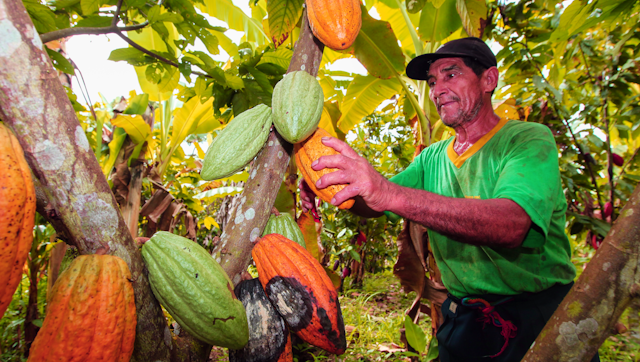Since the start of this year, the price for cocoa traded on the futures exchange has doubled, climbing from US$4,275 a tonne to US$9,481 after earlier hitting an all-time high of US$10,274.
So it would be natural to expect the price of chocolate to soar, and to expect cocoa growers to get more.
But, as surprising as it seems, my calculations suggest neither is likely, although we can certainly expect the price of chocolate to rise.
The price of cocoa is soaring because intense heat and rains have hit harvests in West Africa. Yields are expected to fall short for the third year in a row.
As this has happened, climate change and desertification have shrunk the amount of land suitable for growing cocoa, at the same time as demand for cocoa has continued to grow.
An increase of US$5,000 per tonne means an increase of 50 US cents per 100 grams.
A typical chocolate snack weighing 45 grams includes about 15% cocoa, so it contains seven grams. This means an increase in the cocoa price of US$5,000 per tonne is only capable of increasing the cost of a typical chocolate snack by about four US cents, which is six Australian cents.
But already this year the price of finished chocolate bars has increased by more.
In Europe, Mondelēz (which makes Cadbury) has increased prices by 12–15%. In the United States, Mars has increased prices by 15%.
And those increases come on top of hefty increases in 2023. In a year in which cocoa prices should have pushed up the cost of the cocoa in a typical 45 gram snack by less than one US cent (less than two Australian cents), Mondelēz increased some prices by 15% and Nestlé by 9.5%.
And Mars and Nestlé shrank some of their bars.
This needn’t mean profiteering.
There’s a lot that goes into chocolate in addition to cocoa. Among the other inputs are sugar, milk, dried fruits and nuts, factory labour, wrapping and distribution.
But it does mean the recent explosion in cocoa prices doesn’t explain much about what’s happened to the price of chocolate.
Higher prices no bonanza for growers
In some countries, 90% of cocoa growers don’t earn a living income. Many of the 800,000 cocoa farmers in Ghana survive on just US$2 a day.
The average cocoa farm in West Africa is just three to four hectares, producing less than one tonne per year. These are conditions that can exacerbate child labour, forced labour and deforestation, which itself contributes to climate change.
On the face of it, the increased price will help, allowing farmers to educate their children rather than put them to work.
But it’s not that straightforward. One reason is that although some farmers are getting more per tonne, many are producing fewer tonnes as a result of the hit to harvests.
Farmers don’t get futures prices
Another reason is that in Cöte d’Ivoire and Ghana (which between them produce 60% of the world’s cocoa) governments fix the farmgate price. What happens on the futures market is of little immediate relevance.
And the higher futures prices might not last. If traders become less worried about prices going up, the current high futures prices could fall before they get fed into the prices paid to growers.
As well, farmers get very little of the price – on one estimate only 6–7% of the price. The producers of cocoa products get 40–45%, and the rest is taken up by transport and related costs.
More importantly, researchers estimate that to reach a living income, farmers would need to be getting three to four times what they have been getting, rather than merely twice as much.
And when the price of cocoa goes up, other costs in those poor communities tend to go up as well, not only essentials such as rice but things needed for growing cocoa such as fertiliser.
I look forward to the day when a chocolate company says its prices are going up because it has decided to give the farmers who grow its cocoa a living income.
Some are making welcome steps. Mars has a target of doubling the income of its cocoa farmers in Cote d'Ivoire and Indonesia by 2030.
But we are still a long way from paying growers properly. Although we are certainly paying more for chocolate, right now very little of it is going to the ultimate producers of its most important raw material.
Carolyn Kitto from Be Slavery Free assisted with the preparation of this piece. If you would like to know more about companies’ progress towards paying a living income go to www.chocolatescorecard.com.

